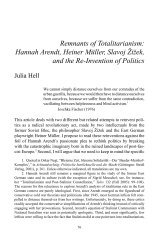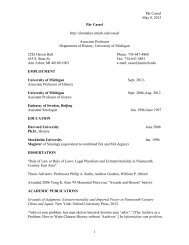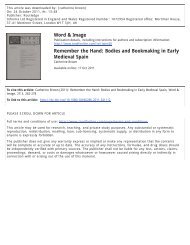Making History Personal: Constantine Cavafy and the Rise of Rome
Making History Personal: Constantine Cavafy and the Rise of Rome
Making History Personal: Constantine Cavafy and the Rise of Rome
Create successful ePaper yourself
Turn your PDF publications into a flip-book with our unique Google optimized e-Paper software.
Frier, “<strong>Making</strong> <strong>History</strong> <strong>Personal</strong>,” page 20<br />
Alex<strong>and</strong>er Helios <strong>and</strong> Cleopatra Selene (twins born in 40), <strong>and</strong> Ptolemy Philadelphus (born in<br />
36). These inflammatory gifts were extremely unpopular in <strong>the</strong> Western Mediterranean (now<br />
under Octavian’s sole control) <strong>and</strong> provided one pretext for <strong>the</strong> final rupture between Antony <strong>and</strong><br />
Octavian.<br />
Map <strong>of</strong> <strong>the</strong> Donations <strong>of</strong> Alex<strong>and</strong>ria<br />
(http://darkwing.uoregon.edu/~klio/maps/rr/do<br />
nations_<strong>of</strong>_alex<strong>and</strong>ria.jpg)<br />
<strong>Cavafy</strong> describes <strong>the</strong> Donations<br />
by conflating two sources: Plutarch’s Life<br />
<strong>of</strong> Antony 54.4-6 62 <strong>and</strong> Cassius Dio<br />
49.41.1-3. In his account, <strong>Cavafy</strong> views<br />
<strong>the</strong> Donations from <strong>the</strong> perspective <strong>of</strong> <strong>the</strong> Alex<strong>and</strong>rian crowd, who “came out in droves / to have<br />
a look at Cleopatra’s children”; but Cleopatra <strong>and</strong> Antony, who presided on golden thrones over<br />
<strong>the</strong> actual event, are altoge<strong>the</strong>r omitted (as is <strong>the</strong>ir daughter Selene), <strong>and</strong> <strong>the</strong> donations are instead<br />
made by a mysterious “<strong>the</strong>y.” 63<br />
The juvenile Alex<strong>and</strong>er (aged 6) is named “king / <strong>of</strong> Armenia,<br />
<strong>of</strong> Media, <strong>of</strong> <strong>the</strong> Parthians,” <strong>and</strong> Ptolemy (aged 2) is to be “king / <strong>of</strong> Cilicia, <strong>of</strong> Syria, <strong>of</strong><br />
Phoenicia”; here <strong>Cavafy</strong> follows Plutarch, Antony 54.4-5.<br />
But for Caesarion he switches to Dio, 49.41.1: “Him <strong>the</strong>y declared greater than <strong>the</strong> boys:<br />
64<br />
/ him <strong>the</strong>y declared King <strong>of</strong> Kings.” In fact, however, on Dio’s own account Caesarion was<br />
actually named co-ruler with Cleopatra (styled “Queen <strong>of</strong> Kings” 65<br />
) over Egypt <strong>and</strong> Cyprus; <strong>and</strong><br />
quently attested use <strong>of</strong> <strong>the</strong> honorific titles Philopator Philometor almost certainly represents ano<strong>the</strong>r claim to descent<br />
from Caesar.<br />
62<br />
In citing Plutarch, I use <strong>the</strong> chapter numbering in <strong>the</strong> more accessible Loeb edition: Perrin, Plutarch’s Lives<br />
IX (1920), ra<strong>the</strong>r than <strong>the</strong> more st<strong>and</strong>ard scholarly numbering found, e.g., in Pelling, Antony (1988).<br />
63<br />
In a commentary on this poem, <strong>Cavafy</strong> noted that he had deliberately minimized <strong>the</strong> role Cleopatra played in<br />
<strong>the</strong> Donations: Haas, “Reading Notes” 34, citing Savidis’s publication (inaccessible to me).<br />
64<br />
As to Caesarion, Dio is <strong>the</strong> only source for this title, unless a Latin inscription from Delos (CIL 3.7232) is<br />
correctly restored to read “King <strong>of</strong> Kings, son <strong>of</strong> Cleopatra,” probably referring to Caesarion. See Hölbl, Ptolemaic<br />
Empire (2001) 255 n.107. Pelling, Antony (1988) 250-251, on Plutarch, Antony 54.7, rightly rejects Plutarch’s conflicting<br />
claim that Antony’s sons were both proclaimed Kings <strong>of</strong> Kings. The title evidently picks up <strong>the</strong> ancient<br />
Persian “Shahanshah”: Griffiths, “βασιλεύς βασιλέων” (1953), <strong>and</strong> Huß, “’König” (1977), <strong>and</strong> Ägypten (2001) 739-<br />
740 – probably anticipating a planned but unexecuted Parthian campaign, Kienast, Augustus (1982) 53.<br />
65<br />
See <strong>the</strong> denarius issued by Antony in 32 BCE, with a reverse bearing Cleopatra’s bust <strong>and</strong> <strong>the</strong> inscription:<br />
CLEOPATRAE REGINAE REGUM FILIORUM REGUM: Crawford, Coinage vol. I (1974) 539, no. 543.
















